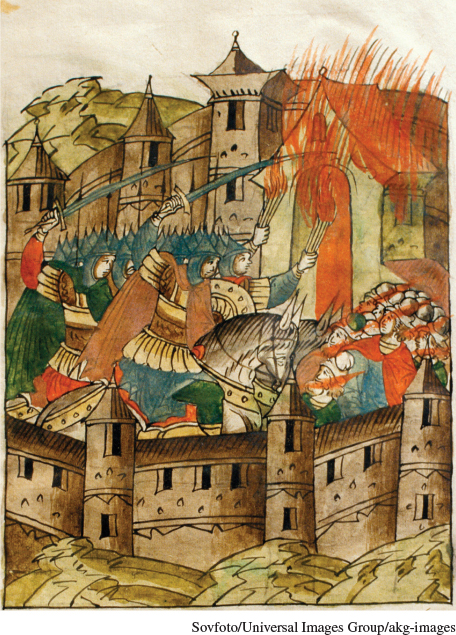Russia and the Mongols
AP® EXAM TIP
You might see questions on the AP® exam regarding interactions between Russians and Mongols.
When the Mongol military machine rolled over Russia between 1237 and 1240, it encountered a relatively new third-
Guided Reading Question
▪COMPARISON
What was distinctive about the Russian experience of Mongol rule?

If the violence of initial conquest bore similarities to the experiences of Persia, Russia’s incorporation into the Mongol Empire was very different. To the Mongols, it was the Kipchak (KIP-
AP® EXAM TIP
Note the varying fate of cities under Mongol rule.
And exploit they certainly did. Russian princes received appointment from the khan and were required to send substantial tribute to the Mongol capital at Sarai, located on the lower Volga River. A variety of additional taxes created a heavy burden, especially on the peasantry, while continuing border raids sent tens of thousands of Russians into slavery. The Mongol impact was highly uneven, however. Some Russian princes benefited considerably because they were able to manipulate their role as tribute collectors to grow wealthy. The Russian Orthodox Church likewise flourished under the Mongol policy of religious toleration, for it received exemption from many taxes. Nobles who participated in Mongol raids earned a share of the loot. Some cities, such as Kiev, resisted the Mongols and were devastated, while others collaborated and were left undamaged. Moscow in particular emerged as the primary collector of tribute for the Mongols, and its princes parlayed this position into a leading role as the nucleus of a renewed Russian state when Mongol domination receded in the fifteenth century.
The absence of direct Mongol rule had implications for the Mongols themselves, for they were far less influenced by or assimilated within Russian cultures than their counterparts in China and Persia had been. The Mongols in China had turned themselves into a Chinese dynasty, with the khan as a Chinese emperor. Some learned calligraphy, and a few came to appreciate Chinese poetry. In Persia, the Mongols had converted to Islam, with some becoming farmers. Not so in Russia. There “the Mongols of the Golden Horde were still spending their days in the saddle and their nights in tents.”22 They could dominate Russia from the adjacent steppes without in any way adopting Russian culture. Even though they remained culturally separate from Christian Russians, eventually the Mongols assimilated to the culture and the Islamic faith of the Kipchak people of the steppes, and in the process they lost their distinct identity and became Kipchaks.
Despite this domination from a distance, “the impact of the Mongols on Russia was, if anything, greater than on China and Iran [Persia],” according to a leading scholar.23 Russian princes, who were more or less left alone if they paid the required tribute and taxes, found it useful to adopt the Mongols’ weapons, diplomatic rituals, court practices, taxation system, and military draft. Mongol policies facilitated, although not intentionally, the rise of Moscow as the core of a new Russian state, and that state made good use of the famous Mongol mounted courier service, which Marco Polo had praised so highly. Mongol policies also strengthened the hold of the Russian Orthodox Church and enabled it to penetrate the rural areas more fully than before. Some Russians, seeking to explain their country’s economic backwardness and political autocracy in modern times, have held the Mongols responsible for both conditions, though most historians consider such views vastly exaggerated.
AP® EXAM TIP
Compare the decline of Mongol rule in Russia with the decline in China and Persia.
Divisions among the Mongols, the disruptive influence of plague, and the growing strength of the Russian state, centered now on the city of Moscow, enabled the Russians to break the Mongols’ hold by the end of the fifteenth century. With the earlier demise of Mongol rule in China and Persia, and now in Russia, the Mongols had retreated from their brief but spectacular incursion into the civilizations of outer Eurasia. Nonetheless, they continued to periodically threaten these civilizations for several centuries, until their homelands were absorbed into the expanding Russian and Chinese empires. But the Mongol moment in world history was over.